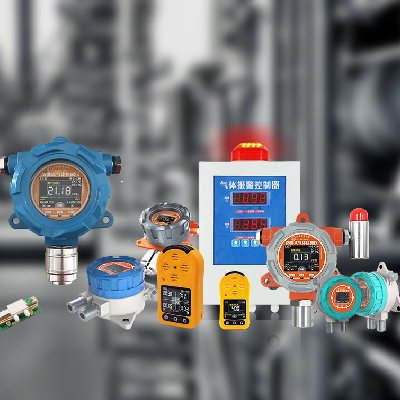Flammable gas detector typically detect the presence of flammable gases in the air through the use of sensors. These sensors are designed to react to the presence of specific flammable gases, such as methane, propane, or butane. The most common type of sensor used in flammable gas detectors is a catalytic bead sensor.

Sensing Technologies in Flammable Gas Detector
Flammable gas detectors utilize a range of sensing technologies to detect the presence of combustible gases. The most common sensing technologies include:

a. Catalytic Combustion Sensors: Catalytic combustion sensors consist of a catalyst that promotes the oxidation of flammable gases, generating a temperature change that is proportional to the gas concentration. When combustible gases come into contact with the catalyst, they undergo a chemical reaction, leading to a rise in temperature that is detected by the sensor. This change in temperature is then converted into an electrical signal, indicating the presence of flammable gases.
b. Infrared (IR) Sensors: Infrared sensors operate by measuring the absorption of infrared light by the target gas molecules. Each gas has a unique absorption spectrum, and when infrared light passes through a gas sample, the presence of specific gases causes a reduction in the intensity of the transmitted light. By analyzing the changes in the infrared light intensity, the sensor can identify the concentration of flammable gases in the environment.
c. Semiconductor Sensors: Semiconductor sensors utilize the conductive properties of metal oxides or other semiconductor materials to detect the presence of combustible gases. When exposed to flammable gases, the conductivity of the semiconductor material changes, leading to a measurable electrical signal that indicates the gas concentration. Semiconductor sensors are sensitive to a wide range of flammable gases and can provide rapid response times.
d. Electrochemical Sensors: Electrochemical sensors rely on the electrochemical reaction between the target gas and an electrolyte within the sensor. When flammable gases come into contact with the sensor’s electrode, they undergo a chemical reaction that generates an electrical current proportional to the gas concentration. Electrochemical sensors are known for their high sensitivity and selectivity, making them suitable for detecting specific gases at low concentrations.
Operating Principles of Flammable Gas Detectors

Flammable gas detectors operate based on the principles of gas diffusion, sensor response, and signal processing. When deployed in an environment where flammable gases may be present, the detectors continuously sample the air to measure the gas concentration. The gas molecules diffuse into the sensing elements of the detector, where they interact with the sensor technology to produce a measurable response.
Upon exposure to flammable gases, the sensing elements within the detector undergo changes, such as temperature variations, electrical conductivity, or chemical reactions, depending on the type of sensor technology used. These changes are then converted into electrical signals, which are processed and analyzed by the detector’s electronics. The electronics compare the measured signals to predefined alarm thresholds and trigger an alarm when the gas concentration exceeds the acceptable limits.
Flammable gas detectors are designed to provide both visual and audible alarms to alert individuals in the vicinity of potential gas hazards. The alarms may include flashing lights, sound alerts, and digital displays indicating the gas concentration levels. Additionally, some advanced detectors are equipped with wireless connectivity and can transmit real-time gas concentration data to centralized monitoring systems for remote monitoring and response coordination.
Applications of Flammable Gas Detectors
Flammable gas detector play a crucial role in ensuring safety and preventing fire and explosion hazards across various industries and settings. Their applications include:
a. Industrial Safety: Flammable gas detectors are widely used in industrial facilities, such as petrochemical plants, refineries, manufacturing plants, and storage facilities, to monitor the presence of combustible gases. By providing early warnings of gas leaks or accumulation, these detectors help prevent potential explosions and protect workers and assets.
b. Environmental Monitoring: In environmental monitoring applications, flammable gas detectors are employed to detect the release of gases from landfills, wastewater treatment plants, and other sources. Monitoring the emission of flammable gases is essential for preventing air pollution and ensuring compliance with environmental regulations.
c. Residential and Commercial Use: Flammable gas detectors are also installed in residential and commercial buildings to safeguard occupants from potential gas leaks, such as natural gas or propane leaks from heating systems, stoves, or gas pipelines. Early detection of gas leaks can prevent accidents and protect occupants from harm.
d. Hazardous Area Monitoring: In hazardous areas where flammable gases may be present, such as confined spaces, storage tanks, and tunnels, flammable gas detectors are deployed to continuously monitor the air quality and provide early warnings of potential hazards.
e. Oil and Gas Exploration: In the oil and gas industry, flammable gas detectors are used in drilling operations, production facilities, and offshore platforms to monitor the presence of hydrocarbon gases and ensure the safety of personnel and equipment.
The significance of flammable gas detectors in these applications cannot be overstated, as they contribute to the prevention of catastrophic events, protection of human lives, and preservation of the environment. By providing early warnings of gas hazards, these detectors enable proactive measures to be taken, such as ventilation, evacuation, or shutdown of operations, to mitigate potential risks.
Conclusion
In conclusion, flammable gas detector are essential devices designed to detect the presence of combustible gases in the air and provide early warnings to prevent potential fire or explosion hazards. These detectors employ various sensing technologies, including catalytic combustion sensors, infrared sensors, semiconductor sensors, and electrochemical sensors, to achieve reliable and accurate gas detection. Flammable gas detectors play a crucial role in ensuring safety and preventing fire and explosion hazards across various industries and settings, including industrial facilities, environmental monitoring, residential and commercial use, hazardous area monitoring, and oil and gas exploration.
